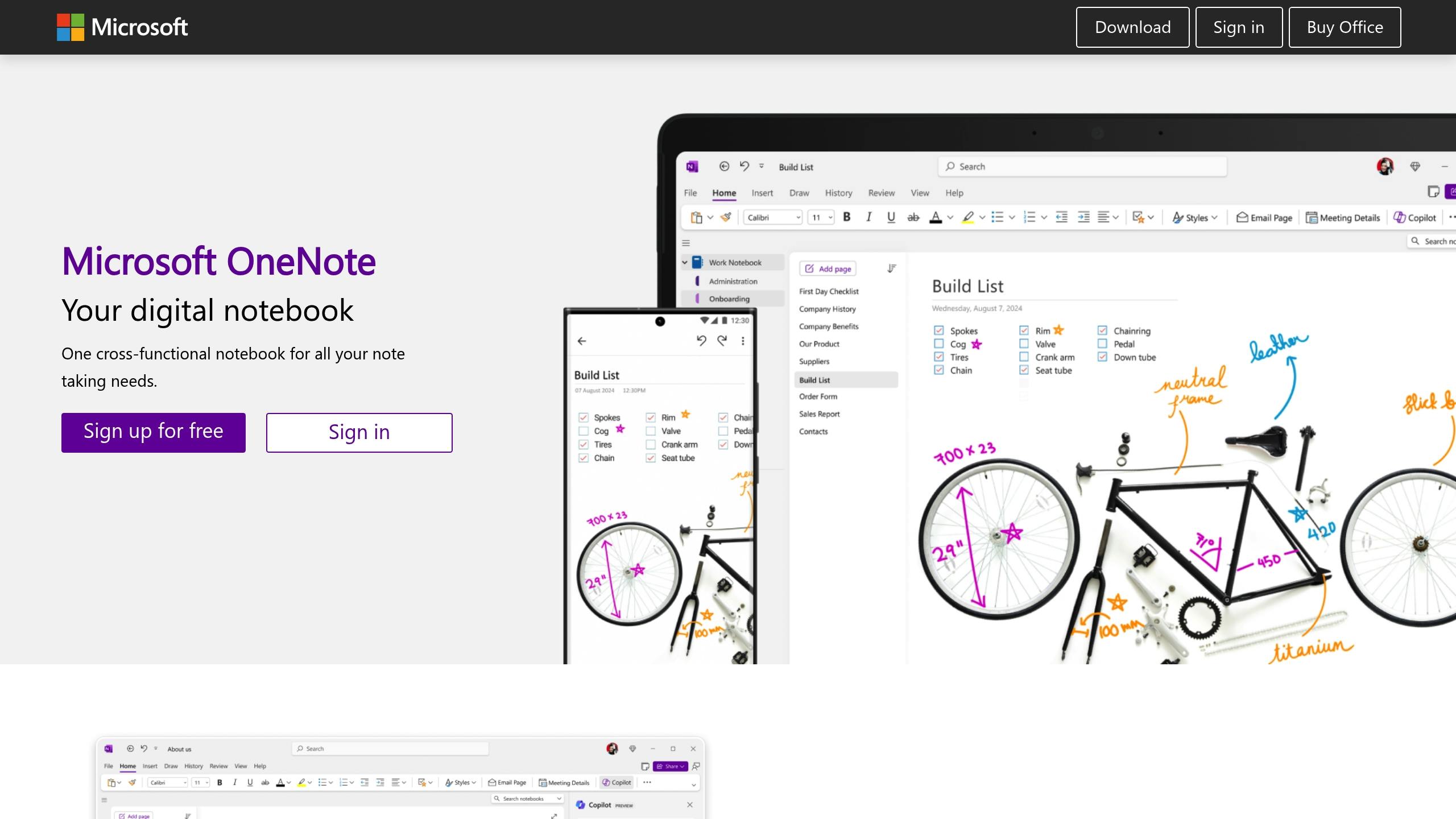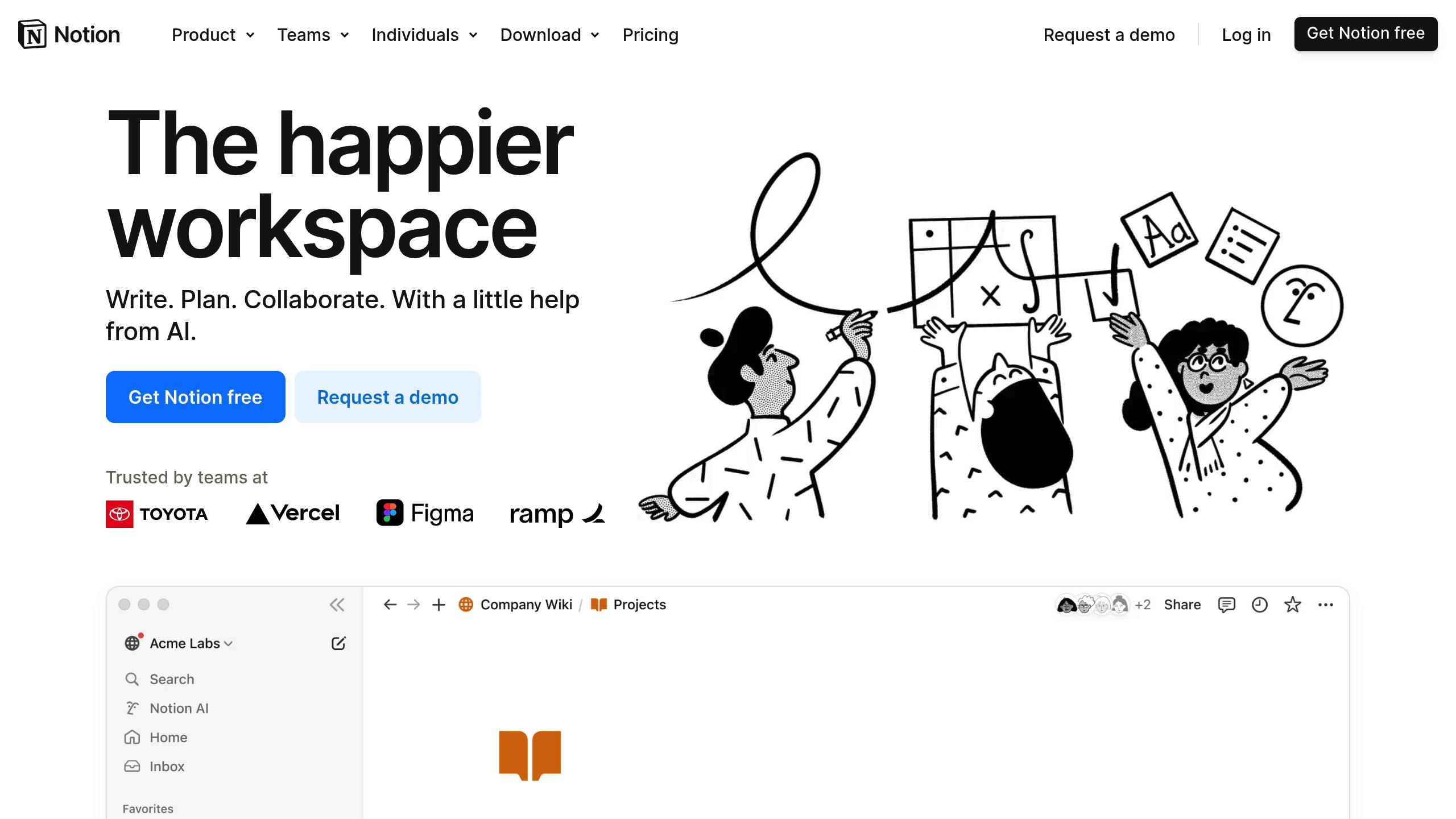
Top 5 Note-Taking Apps with Built-In Flashcard Features for Students
Studying efficiently means combining good notes with active recall, and these apps let you do both in one place. Here are five top note-taking apps that also create flashcards:
- intellecs.ai: AI-powered notes and flashcards, smart organization, and markdown formatting. Desktop only. $25/month.
- Evernote: Syncs across devices, supports multimedia notes, and integrates with tools like StudyBlue for flashcards.
- OneNote: Flexible notebooks, great for handwritten notes, integrates with Microsoft 365. Free with Microsoft 365 subscription.
- Notion: Customizable flashcards using boardview databases, integrates with NeuraCache for spaced repetition.
- RemNote: Fast flashcard creation, spaced repetition, and offline access. Free plan available.
Quick Comparison Table:
| App | Price | Device Compatibility | Key Features | Best For |
|---|---|---|---|---|
| intellecs.ai | $25/month | Desktop | AI-generated flashcards, markdown | AI-powered learning |
| Evernote | Free/$10.83+ | All devices | Multimedia notes, StudyBlue | Versatile note organization |
| OneNote | Free | All devices | Handwritten notes, Microsoft 365 | Collaboration and handwriting |
| Notion | Free/$8+ | All devices | Customizable flashcards, NeuraCache | Flexible study setups |
| RemNote | Free/$6+ | All devices | Spaced repetition, PDF annotation | Quick flashcard creation |
Choose the app that fits your study habits and device needs.
The NEXT LEVEL tool for students? | RemNote Review 2023

1. intellecs.ai

intellecs.ai combines note-taking and flashcard creation with AI-powered tools to streamline studying. Its smart document organization system helps students arrange their study materials with ease, eliminating the hassle of hunting through scattered notes.
The platform’s AI-enhanced note-taking feature automatically expands, clarifies, and refines notes, ensuring key concepts are well-documented and easy to grasp. This is especially helpful during fast-paced lectures when capturing everything can be challenging.
Students can either create flashcards manually or let the AI generate them automatically, saving time while maintaining control. Key features include:
| Feature | How It Helps Students |
|---|---|
| Smart Note Organization | Simplifies material structuring with drag-and-drop functionality |
| AI-Generated Flashcards | Saves time by turning notes into study cards |
| Active Recall System | Boosts memory retention through regular review |
| Markdown Formatting | Makes note formatting quick and intuitive during lectures |
With keyboard shortcuts and a unified dashboard, students can seamlessly switch between taking notes and reviewing them without losing focus.
Priced at $25/month, intellecs.ai combines tools that would typically require multiple subscriptions. The flat rate includes unlimited access to all features, making it a practical option for students who frequently create and review study content.
Currently, intellecs.ai is designed exclusively for desktops and laptops, prioritizing focused, in-depth study sessions. It supports PDF files, with plans to include additional formats in future updates.
2. Evernote

Evernote combines note-taking and flashcard creation, making it accessible across all your devices. As Well+Good puts it:
"Consider Evernote to be your go-to hub for not just to-do lists but all of your notes. The organizational possibilities are expansive, and everything syncs across all of your devices that have the app enabled, so you'll never miss a beat." – Well+Good
This setup reduces the need to switch between apps, keeping study sessions more focused and efficient.
Students can turn their notes into flashcards using several methods:
| Method | Description | Best For |
|---|---|---|
| Two-Column Tables | Converts notes into Q&A flashcards | Quick study material creation |
| Web Clipper Integration | Transforms web content into flashcards | Research-based studying |
| StudyBlue Connection | Imports notes as interactive study aids | Comprehensive review sessions |
| NeuraCache | Turns highlights into reviewable flashcards | Active recall practice |
Evernote supports a variety of formats - text, images, audio recordings, scanned documents, and PDFs - making it easy to capture and organize lecture content. The Verge highlights its versatility:
"It feels like there are endless ways to use Evernote… Use it for school, work, life, and beyond." – The Verge
The Cornell Notes template is particularly handy for converting structured notes into flashcards. In 2024, Evernote introduced 100 updates aimed at improving usability. Features like automatic syncing, advanced search, and real-time collaboration ensure your study materials are always available, whether you're working alone or in a group.
3. OneNote

OneNote serves as a digital notebook designed for both note-taking and flashcard creation. Its flexible layout allows students to organize their work into notebooks, sections, pages, and containers.
| Level | Purpose | Benefits |
|---|---|---|
| Notebooks | Organize by subject/course | Keeps different classes separate |
| Sections | Group by topic/unit | Makes content easier to navigate |
| Pages | Store individual lectures | Offers unlimited writing space |
| Containers | Manage note elements | Lets you move content freely |
Using this structure, students can easily create flashcards. For example, type a term, add the definition underneath, and use the collapse feature to hide answers - this works well for vocabulary, concepts, or even image-based learning.
OneNote integrates seamlessly with Microsoft 365, making it a powerful tool for collaboration. Students can share notebooks through email for group projects, annotate PowerPoint slides, collect online research, and access everything via Microsoft Teams.
For those who like handwriting, OneNote shines on tablets. Students can draw diagrams, solve equations, or sketch chemical structures, then convert them into flashcards for review. With automatic syncing across devices, study materials are always within reach, whether you're at home or on the go.
The tagging tool also helps by marking important concepts for quick and focused review.
4. Notion

Notion combines note-taking and flashcard creation seamlessly, using its boardview database to build study materials. Each Notion page serves as a flashcard with a simple structure:
| Card Component | Implementation | Purpose |
|---|---|---|
| Front | Page Title | Displays the question or concept |
| Back | Database Property | Holds the answer or explanation |
| Tags | Categories | Sorts cards by subject or topic |
| Status | Progress Tracking | Tracks understanding levels |
Notion allows flexible ways to review flashcards. You can create different views for various subjects, making it easy to focus on specific topics during study sessions. The 'Quick Add' feature lets you create flashcards on the fly without disrupting your workflow.
For better retention, Notion works with tools like NeuraCache, which supports spaced repetition. Marcin Czech, founder of NeuraCache, highlights its benefits:
"One of the most powerful features of NeuraCache is its 'Today's Queue' - a daily routine you need to perform to build your Long-Term memory 🧠 It's like a daily 10 minutes gym for your mind."
A June 2022 template by Red Gregory showcases how to use Notion's boardview database effectively. This template turns any Notion page into a study card using formulas, which is especially helpful for subjects involving heavy memorization.
Tips for Using Notion Flashcards:
- Break complex topics into smaller, focused cards.
- Set up separate views for different study phases.
- Use tags to organize cards by subject and difficulty.
- Track progress with status indicators.
- Review cards in both directions - question-to-answer and answer-to-question.
Additionally, Notion's built-in AI can summarize texts and generate study materials for faster review. The toggle feature offers a simpler flashcard format for quick study sessions, providing an alternative when you don't need a full database setup. These tools make studying more organized while boosting active recall.
5. RemNote
RemNote combines note-taking with flashcard creation, providing a streamlined way for students to study and retain information. Its Concept-Descriptor Framework helps organize notes in a way that aligns with how the brain processes information, making it easier to recall and understand complex topics.
Flashcard creation in RemNote is incredibly fast - students can create a new card in just 0.43 seconds by typing "==" in their notes. This quick process ensures that note-taking remains smooth and uninterrupted. The platform offers several types of flashcards to suit various learning needs:
| Flashcard Type | Best Used For | Features |
|---|---|---|
| Basic | Simple concepts | Front/back format |
| Fill-in-blank | Vocabulary | Partial text hiding |
| Image occlusion | Diagrams/charts | Hide/reveal portions |
| Multiple-choice | Test preparation | Quiz-style format |
| Two-directional | Language learning | Reversible cards |
RemNote also uses a spaced repetition system that schedules reviews at optimal intervals to maximize retention with minimal effort. According to user feedback, 89% of students reported feeling less stressed about exams after using the platform.
Harvard medical student James Lin highlights its benefits:
"RemNote streamlines this process unlike anything else out there. It allows you to study while facilitating memorization and card creation without breaking flow. It's a priceless superpower for all students!"
Savannah Feder from UBC adds:
"RemNote has quickly become one of my favorite products of all time... For any students out there, I scored top marks with half as much effort the term I switched to RemNote. Works like magic 🪄"
Key Features
- Exam scheduler: Adjusts study plans based on test dates
- Annotation tools: Supports PDFs and PowerPoints for better material integration
- Offline access: Syncs across devices for uninterrupted studying
- AI-powered tools: Speeds up flashcard creation
RemNote's hierarchical organization system helps students break down complicated topics into smaller, connected pieces. This, combined with active recall tools, has made it a go-to for over 1,000,000 students.
The platform also offers flexible practice modes, including spaced repetition and comprehensive reviews, so students can tailor their study approach. Features like flashcard previews ensure cards are formatted correctly, while the sidebar tracker shows how many cards are due for review each day.
With its variety of tools and study modes, RemNote stands out as a practical choice for students looking to optimize their learning process. It’s a solid contender if you’re searching for the perfect study app.
Which App Should You Pick?
After reviewing the features of both apps, here's a breakdown to help you decide which one matches your study habits.
intellecs.ai combines AI-powered tools for note-taking and flashcard creation in one platform. It simplifies study workflows with smart features like integrated AI chat and automated flashcard generation.
RemNote, rated 4.8/5 from 616 App Store reviews, offers a strong free plan packed with features. According to users, 89% reported reduced exam stress after using the app.
Here’s a quick comparison to help you choose:
| Study Need | Best Choice | Why It Works |
|---|---|---|
| AI-Powered Learning | intellecs.ai | Features like AI chat, smart search, and automated flashcard creation. |
| Budget-Friendly Option | RemNote | A free plan with extensive features. |
| Fast Flashcard Creation | RemNote | Instant card generation with smooth integration. |
| All-in-One Study System | intellecs.ai | Combines multiple study tools into one platform. |
Many students praise RemNote for its efficiency. As Harvard medical student James Lin shares:
"RemNote streamlines this process unlike anything else out there. It allows you to study while facilitating memorization and card creation without breaking flow. It's a priceless superpower for all students!"
Things to Consider Before Choosing:
- Budget: intellecs.ai offers an all-in-one solution that replaces multiple subscriptions. RemNote, on the other hand, provides a robust free tier.
- Learning Style: If you need AI-powered assistance, go for intellecs.ai. Prefer a focus on note organization and spaced repetition? RemNote is your pick.
- Device Compatibility: intellecs.ai works on desktop/laptop with PDF support. RemNote supports a wider range of devices and file formats.
Both apps can help improve academic performance when used regularly. The right choice depends on your specific needs and preferences.